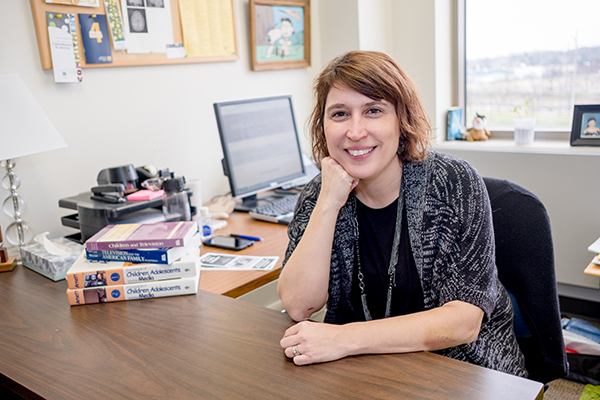Q&A: Professor Sarah Rosaen discusses her research on media and children

UM-Flint professor of communication Sarah Rosaen researches the impact of media on children and adults. Dr. Rosaen discusses her ongoing work in the field, advice for parents regarding media and their children, and more in this Q&A with University Communications & Marketing.
Q: Would you summarize your current projects and research related to the impact of media on children?
A: I have two projects I am working on right now about children and media. First, I made videos and brochures to help parents manage media at home (see links to these resources in sidebar). I have materials for children between 0-2, 2-5, and 5-8 years-of-age. These materials focus on how the cognitive development of the child heavily impacts what they can understand and how they are impacted by the media. Children go through substantial developmental changes as young children, so each video and brochure provides a tailored way to think about children at different ages.
The other project is a collaboration with two faculty members at the University of Cincinnati, Nancy Jennings and Omotayo Banjo. The research study tests whether children trust television characters less when the character is dishonest. In real life dishonesty can affect trust in social relationships and when trust is compromised it can change the way we interact with people. We want to see whether the trust children have of a television character goes beyond what they think about the character and whether that trust affects their beliefs and willingness to interact with people who are similar to the character in real life.
Q: What should parents know about the cognitive changes in children, and how these changes affect how and when children should use or be exposed to media?
A: These recommendations focus on children who are 8-years-old or younger. First, young children do not understand storylines. They do not have the ability to tie cause to effect and they are not logical. This is why some children think they can fly, like Superman. Because of this, simple, slow-paced programs are best because they are not overwhelming. Second, young children do not understand the difference between fantasy and reality. Telling them something is not real and to not be scared won't help very much. It is better just to avoid watching something or to stop watching something. Young children usually focus on striking images on the screen rather than learning a lesson. Basically, whatever is right in front of them will be the thing they react to, like a scary witch. Third, children learn the best from real-life people. Therefore, parents who know what their child is watching or who watch with them are able to answer questions and help children understand what the media is telling them.
Q: The forms media take are rapidly changing. What new challenges are there now because of these changes?
A: One of the challenges parents face is keeping up with the numerous media choices available to children. Inevitably as children grow older, parents' rules and restrictions on media use loosen. The early years become an important time to learn how to use the media and understand it. Basically, parents are teaching their children in the early years how to understand and regulate the media for themselves.
Q: What should parents know about screen time, and how should they approach issues related to screen time with their children?
A: One of the most important things young children are doing is learning. They learn the best from real-life people, so reducing screen time during early childhood helps children to learn from the real world more than the media world. Also, less screen time means fewer negative effects from the media like bring frightened and seeing violence. For children 2-8-years old the recommendation is to limit screen time to 2 hours or less a day. And for children 2-years-old or younger keep it to 30-60 minutes a day because their brains have a harder time dealing with all of the stimuli (bright lights and loud sounds) in the media.
Additionally, when you select the media they use during those hours, think about a few things. First, make sure the media they watch matches your family values. You can figure this out partly by previewing what they watch; that way you know it is appropriate from your perspective. Previewing also helps because you can eliminate programs that are too fast-paced or are too scary. Finally, explaining to your child why you have the rules you have can help them understand the restrictions. In general, children follow the rules if they understand why they exist.
Q: From your perspective, how important is it to connect academic research with community outreach?
A: I think connecting research with the community is very important and in some cases the only way the research is going to provide any real change. Fortunately, there are quite a few children and media researchers that are creating tools for parents and teachers so they can learn about the research on children and media. In fact, one of the main resources I used when putting together the videos and brochures for home media management is a book called Plugged in: How Media Attract and Affect Youth. This is a great book for parents to learn about how media affects children at all ages.
Related Posts
No related photos.
- College of Arts, Sciences & Education
- Communication Studies
- Community
- Q & A
- Research
- University News
UM-Flint News
The Office of Marketing & Communications can be reached at mac-flint@umich.edu.